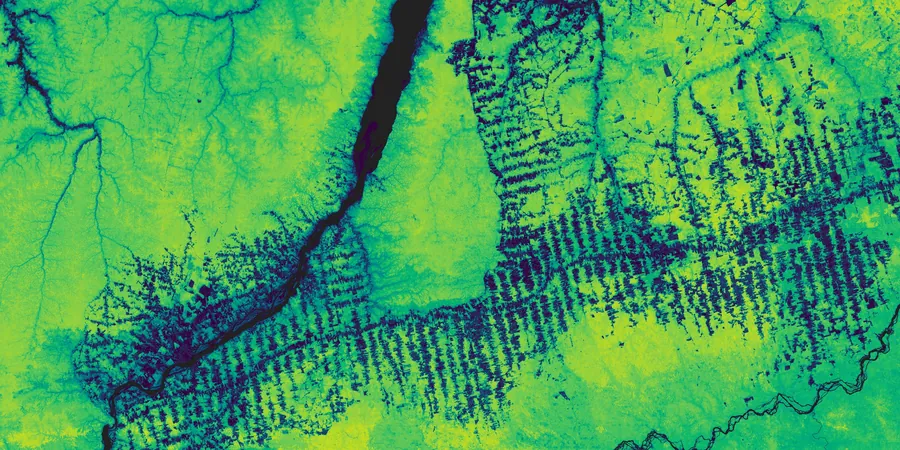
How Forest Carbon Data is Revolutionizing Climate Action
2024-11-15
Author: Noah
Introduction
In a shocking revelation that sends ripples through the environmental community, a recent report has found that the Earth's land carbon sink absorbed an astonishingly low amount of carbon last year. This alarming trend suggests that the ecosystems that have historically offset our carbon emissions could be nearing their breaking point. As climate change accelerates, the urgency to cut emissions and protect our forests has never been more critical.
The Complexity of Carbon Measurement
While tracking fossil fuel emissions may seem straightforward, understanding the complex mechanisms of carbon storage across the globe's diverse ecosystems poses significant challenges. Events such as the catastrophic 2023 wildfires in Canada's boreal forests threaten to exacerbate these issues, creating even more obstacles for accurate carbon accounting.
The Need for Improved Data
The degradation of ecosystems is currently outpacing our understanding of the carbon cycle, revealing the need for improved data sources and methodologies that maintain scientific integrity while providing timely insights. A more nuanced understanding of how carbon sinks and sources are evolving on a granular level is vital as we hasten our efforts to combat climate change.
National Climate Targets and Global Collaboration
According to The Guardian, “at least 118 countries are relying on land to meet national climate targets.” However, these nations cannot achieve meaningful conservation without a repertoire of tools to inform their decisions. Coordinated efforts among nations using data from ground-level measurements and satellite technology are essential in this endeavor; no effort is too grand when the planet's future hangs in the balance.
Collaborations for Climate Action
Establishing collaborations between public and private institutions can tackle historical challenges that reduce individual effectiveness. These partnerships are essential in forging a comprehensive approach to some of the most pressing environmental issues we face.
Innovations in Data Collection
With COP29 ongoing, exciting partnerships are emerging to aid in climate action. One notable initiative involves the Forest Carbon product, powered by NASA’s Global Ecosystem Dynamics Investigation (GEDI) mission, which offers real-time data to government officials and land managers. This innovative dataset estimates aboveground forest carbon, tree height, and canopy cover worldwide, providing quarterly updates that can lead to actionable insights.
The Role of Trees
Trees represent the Earth’s simplest and most effective carbon storage solution, but challenges arise when acquiring reliable, updated data affordably. The Forest Carbon product leverages remote sensing to deliver insights ranging from global forest metrics to specifics on individual trees, facilitating the transition from observation to proactive measures.
Prioritizing Conservation Efforts
A staggering 40% of the Amazon Rainforest is still unprotected, according to recent investigations. These vulnerable areas are critical in the battle against climate change, harboring the largest trees and most extensive canopy cover. Delay in protection increases the risks of devastating wildfires and logging. Leveraging data reports is essential for directing conservation efforts toward these at-risk areas.
Unpacking Policy Drivers Behind Carbon Dynamics
The health of vital carbon sinks like the Amazon Rainforest is not only about where carbon is lost or gained but also about understanding the reasons behind these changes. Utilizing Forest Carbon data, analyses have traced extensive carbon loss in southern Peru to illegal deforestation linked to rampant gold mining, highlighting the need for targeted policy measures.
Securing Integrity in Voluntary Carbon Markets
With the surge in voluntary markets as industries strive to offset their carbon footprints, skepticism around their effectiveness has risen. This is where carbon rating agencies like BeZero step in, using Forest Carbon data to assess the credibility of different markets. This ensures that investments in carbon offsets are genuine and not just a green façade.
Reimagining a Greener Future
Hope springs eternal in the realm of reforestation, especially in Brazil, where large-scale efforts aim to revitalize the ecosystem and provide authentic carbon credits. The Amazon presents a remarkable opportunity: reforestation efforts could tap into 15% of the global carbon removal market, an opportunity valued up to $1.2 trillion, dwarfing the financial incentives compared to the intrinsic value of restored ecosystems.
Mitigating Wildfire Risks
Faced with the threat of utility-induced wildfires, Pacific Gas and Electric Company (PG&E) is turning to innovative models based on tree canopy height built from Forest Carbon data. As vegetation contact is the leading cause of ignitions, understanding the landscape's height and distribution is key to predicting and preventing catastrophic fires.
Conclusion
High-quality, high-resolution data on forest structures and carbon reserves is more crucial than ever across various sectors. As challenges to sustainability and carbon handling intensify, this data not only enables strategic decisions but also lays the groundwork for meaningful impacts. The expansion of science-driven solutions will undoubtedly continue to play a pivotal role in advancing both vital research and tangible applications in the fight against climate change.









 Brasil (PT)
Brasil (PT)
 Canada (EN)
Canada (EN)
 Chile (ES)
Chile (ES)
 España (ES)
España (ES)
 France (FR)
France (FR)
 Hong Kong (EN)
Hong Kong (EN)
 Italia (IT)
Italia (IT)
 日本 (JA)
日本 (JA)
 Magyarország (HU)
Magyarország (HU)
 Norge (NO)
Norge (NO)
 Polska (PL)
Polska (PL)
 Schweiz (DE)
Schweiz (DE)
 Singapore (EN)
Singapore (EN)
 Sverige (SV)
Sverige (SV)
 Suomi (FI)
Suomi (FI)
 Türkiye (TR)
Türkiye (TR)